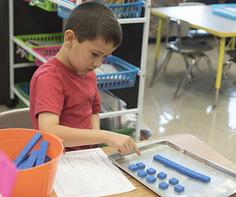
Superintendents
Present ESSA Accountability Model Ideas at Special Work Session
Over the winter, a group of local school superintendents
worked in conjunction with NCDPI accountability staff to develop models for
elementary, middle and high school accountability for North Carolina’s Every
Student Succeeds Act (ESSA) plan. These models were presented and discussed with the
State Board of Education at a special May 2 planning session held the
afternoon before the usual Board meeting days.
The proposed models would include performance indicators (60
percent minimum) and student success indicators (40 percent maximum) for each
level of schooling. For elementary and middle schools, end-of-grade proficiency
in English language arts, mathematics, and science continue to be key elements.
New measures would include the progress of English language learners (a new
federal requirement) and a student survey intended to capture student
observations about school climate, safety and the use of digital learning
tools. The survey would be piloted before it is used in the model. Student
participation in extracurricular and co-curricular activities also would be a
student success indicator.
At the high school level, the proposed model would focus on
end-of-course proficiency and academic growth rates in English II and Math I, the 4-year
cohort graduation rate, and English learning progress as well as biology
proficiency and academic growth. To capture student success indicators, the
model would use a college and career readiness index to include the attainment
of industry credentials, IB diplomas, AP Exam scores of 3 or better, ACT
Workkeys silver certificates, college credit, and ACT performance. A student
survey on school safety/climate and digital learning and student participation
in extracurricular and co-curricular activities also would be in the high
school model.
Board members and superintendents discussed these proposals
and other details about the state’s ESSA plan. The plan is scheduled for
submission to the US Department of Education in September, so the plan will be
finalized this summer to provide time for the Governor’s review before
submission at the federal level.
|
 Study Presented on Return
on Investment for Public School Graduates
Over a 35-year working career, a high school graduate will
earn an estimated $311,591 more than peers who did not graduate from high
school. In addition, high school graduates have lower incarceration rates,
court costs, unemployment costs and health care costs than people who did not
graduate from high school.
These findings were presented by NCDPI Intern Harrison
Wicker at the May State Board of Education meeting. His work also noted that
graduates earn more, spend more and pay more taxes to support services that
benefit North Carolinians overall. The overall return on investment for high
school graduates is $111,203 because they cost less to the state and contribute
more to society.
In considering how to do more to boost high school
performance and graduation rates, District and School Transformation (DST) services
provided by the Department of Public Instruction can make a difference. In
fact, the presence of these services is associated with a 1.75 percent higher
graduation rate than in similar high schools without DST support. For the 23
high schools served by DST, that means approximately 54 more students
graduating each year.
|

Revised K-8
Mathematics
Standards Discussed
Since November 2016, NCDPI staff members have been working
on revisions to the K-8 mathematics standards beginning with a data review and
followed by three drafts informed by teams of classroom teachers, public
comments and surveys.
More than 7,000 educators and 830 community members and
parents provided survey feedback or participated in focus groups. The third
draft was presented to State Board members along with examples of the kinds of
revisions that were made. In summary, 16 standards have major changes, 173
standards have a minor change, 19 standards stayed the same, 4 were removed,
and 20 standards were integrated into others. Three new standards were added. Revisions
were focused on content, vertical alignment, clarity and providing grade
appropriate expectations.
Board members will return to the standards for possible
action in June, and implementation in the 2018-19 school year with end-of-grade
assessments aligned to the new standards for the first time. During the 2017-18
school year, professional development and supporting materials will be
developed and distributed statewide.
|
Bertie County School
District Financial Recovery Plan Presented
The Bertie County School district is in financial distress
and has been cited with material weaknesses and significant deficiencies, as
outlined in a report provided by Alexis Schauss, NCDPI School Business
director.
Schauss and the director of Fiscal Management at the Local
Government Commission met with Bertie’s superintendent, finance officer
and an independent auditor to discuss the 2016 financial statement audit,
corrective actions taken and current financial status. Schauss also met with the
Bertie County Commissioners, and the Financial Business Services School
Nutrition Section performed a site visit to provide technical assistance.
The school district has taken a number of steps to improve
its situation, including replacing the former superintendent with Dr. Steven
Hill, effective December 2016, replacing the finance officer with Lisa Rabon
(February 2017), engaging a new audit firm, and recommending a 6.16 percent
personnel reduction starting in 2017-18. The district also is collecting
unrecognized revenue, including four years of unrecognized revenue, four years
of sales tax refunds and indirect costs for both federal programs and child
nutrition; and reducing contracted services and implementing accounting
procedures and internal controls to support sound financial management.
Bertie has requested approval of its financial recovery plan
dated April 13, 2017, including a five-year plan to reduce its general fund
deficit, estimated to increase to approximately $828,379 by June 30, 2017. This
item will return to the Board for action in June.

Charter Schools
Recommended to Open in 2018-19
Fifteen new charters are under consideration to open in
2018-19. Board members reviewed the recommendations of the NC Charter Schools
Advisory Board to approve the following schools:
- Anson Charter Academy – Anson Academy
- Ascend Leadership Academy – Lee County
- Bonnie Cone Classical Academy - Mecklenburg County
- Carolina Charter Academy – Wake County
- Davidson Charter Academy – Davidson County
- East Voyager Academy – Mecklenburg County
- Essie Mae Kiser Foxx Charter School – Rowan County
- Global Achievers School – Nash County
- Monroe Charter Academy – Union County
- Moore Montessori Community School – Moore County
- Next Generation Academy – Guilford County
- Raleigh Oak Charter School – Wake County
- The Experiential School of Greensboro – Guilford County
- The Paideia Academy – Cabarrus County
- West Lake Preparatory – Lincoln County
|
 National Title I
Distinguished School Recognized
Saluda Elementary School, Polk County Schools, has been
named a National Title I Distinguished School. Principal Cari Maneen and
third-grade teacher Melissa Gillespie were recognized at the May State Board of
Education meeting for the school’s honor.
Saluda Elementary is an A+ School
with teachers addressing the state standards through interdisciplinary thematic
units combined with arts integration and hands-on experiential learning.
|
 North Carolina’s
National Blue Ribbon Schools Honored
Eight North Carolina schools have been named as National
Blue Ribbon Schools, an honor recognizing schools where students either achieve
very high learning standards or are making notable improvements in closing the
achievement gap.
The schools and the school representatives who attended the
Board meeting to receive these honors are:
• Bald Creek
Elementary School, Yancey County Schools; Sherry Robinson, principal and Lori
McCourry, teacher
• Central Academy of
Technology and Arts, Union County Schools; Kim Fisenne, principal
• Davis Drive
Elementary School, Wake County Schools; James Mack, principal; Karen Eck, PTA
President; Paige Everson, school counselor; and Dr. Mark Savage, area
superintendent
• Jay M. Robinson
Middle School, Charlotte-Mecklenburg Schools; Michael Milliote, principal, and
Meredith Cabana, assistant principal
• Morrisville
Elementary School, Wake County Schools; Michael Matthews, principal
• Pisgah Elementary
School, Buncombe County Schools; Jeanann Yates, principal; Candie Sellers,
elementary schools director; and Leslie Cox, teacher
• The Early College
at Guilford, Guilford County Schools
• Wrightsville Beach
Elementary School, New Hanover County Schools; Jackson Norvell, principal
|
|